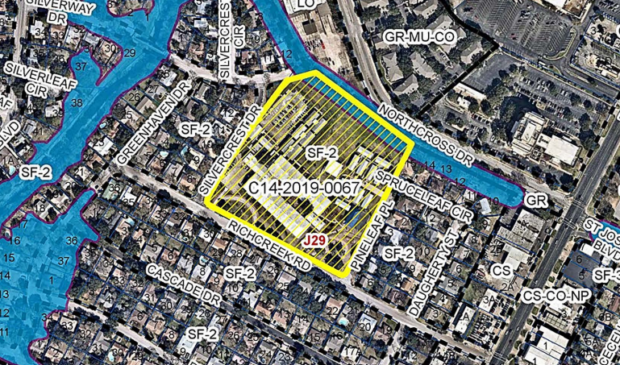ZAP recommends rezoning AISD property for commercial use
Thursday, May 23, 2019 by
Jessi Devenyns Austin Independent School District’s Rosedale School is a special institution that serves students of all ages with severe disabilities, including children who are medically fragile or who need intensive behavioral support. Many of these special-needs children require intensive medical care, which requires them to frequently leave school and as a result, fall behind in class.
In an attempt to remedy this situation, AISD has come up with a creative partnership idea that would allow a private clinic on-site to serve the student population. Using $40 million of funding from a $1 billion bond voters passed in 2017, AISD plans to move students and faculty out of the Rosedale School’s current 80-year-old building and into a brand-new facility at 2608 Richcreek Road in the Allandale neighborhood, on a tract of land that used to be the Lucy Read School.
The facility, according to Leah Bojo of the Drenner Group, who was representing AISD at the May 21 meeting of the Zoning and Platting Commission, would include a medical clinic of up to 20,000 square feet.
In order for this solution to become a reality, however, AISD needs a zoning change.
“I know this is not a normal request, but this is not a normal outcome,” said Bojo.
Although there is no firm partner to run the medical facility, AISD is in talks with several medical providers that would serve Rosedale students as well as pediatric patients from Central Texas.
“To say that they are open to the public may be a little misleading,” explained Drew Johnson, the director of bond planning and project controls. He said that in Central Texas, the number of kids who require comprehensive services of this nature amounts to “maybe only a few thousand children.”
In addition to concerns about having a private business on public school land, commissioners had questions about how taxes would be levied, how the school would be secured when non-students arrive, who would pay for the construction, and how commercial zoning would affect the value of the 9.3-acre parcel and the ramifications of that zoning in the event of a future sale.
“You’ve got some legal questions that you need to ask down the road,” Commissioner Ann Denkler noted.
Johnson explained to the commission that while the construction of both the school and the medical facility would be completed with bond dollars, the medical provider would pay an annual fee or sign a lease agreement for a minimum of 10 years. Additionally, in the event that the space use needed to be altered at a future date, “we would own the space, and we would try to design it in a way that would be as flexible as possible,” said Johnson.
As for the potential future sale of the property, Bojo said, “AISD is investing a lot of bond dollars into a very specialized facility, so they’re not going to sell it.”
Even with support for the collaboration from all sides, several of the commissioners as well as many residents expressed hesitation over having a commercial site in a neighborhood with limited access.
The issue, said neighbor Joseph Parsons, was not whether the students should have medical services easily accessible, but whether a change in zoning is the best way to provide them with that care. “Can you think of any possible way to operate any sort of medical clinic for these kids without changing the zoning?” he asked.
“That,” Chair Jolene Kiolbassa said, “is the heart of the matter.”
After tossing around ideas on how to use interlocal agreements and different permutations of zoning, the commission decided to echo city staff’s recommendation and recommend General Office (GO) commercial zoning with a conditional overlay that prohibits uses other than a medical office, hospital services (limited), public schools, and uses that cannot be eliminated by federal law. The commission also recommended a cap of 20,000 square feet on the allowable square footage of the medical clinic.
The motion passed 7-1-1 with Kiolbassa voting against the motion and Commissioner Jim Duncan abstaining. Commissioner Nadia Barrera-Ramirez was absent.
As a word of caution, Duncan suggested that city staff look into how to handle innovative partnerships on school campuses in the future.
“This is only, I think, the start of what could become a regular thing,” he said.
Photo courtesy of city of Austin.
The Austin Monitor’s work is made possible by donations from the community. Though our reporting covers donors from time to time, we are careful to keep business and editorial efforts separate while maintaining transparency. A complete list of donors is available here, and our code of ethics is explained here.
You're a community leader
And we’re honored you look to us for serious, in-depth news. You know a strong community needs local and dedicated watchdog reporting. We’re here for you and that won’t change. Now will you take the powerful next step and support our nonprofit news organization?








